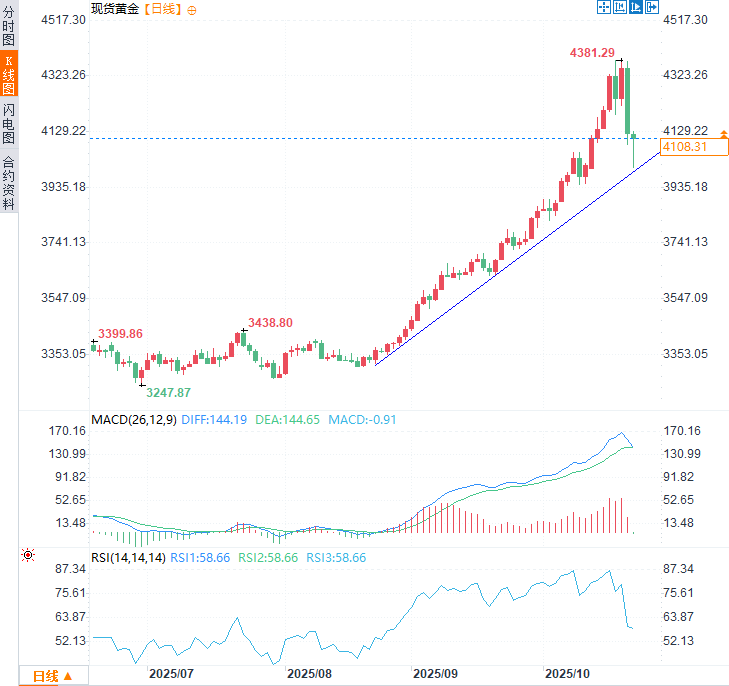Former Federal Reserve adviser warns: Liquidity crisis has broken out, "gold sell-off" is an important signal
2025-10-22 10:23:59

The warning comes at a time of significant market turmoil. On Tuesday, the Dow Jones Industrial Average rose more than 200 points, while the S&P 500 neared an all-time high, driven by strong earnings from companies like General Motors and Coca-Cola. This optimism contrasts with pressure in fixed income and commodity markets.
Danielle DiMartino Booth, who served as an advisor to former Dallas Fed President Richard Fisher from 2006 to 2015, noted that this divergence is unsustainable. As CEO of the macroeconomic consulting firm QI Research, Booth has long been critical of the Fed's policies, believing they have sown deep-seated hidden dangers.
“It seems clear that enough liquidity is being drained from the system that the Fed is going to be forced to take a backseat,” Booth told Kitco News in an interview.
She was referring to the Federal Reserve's ongoing quantitative tightening (QT) program, which allows up to $95 billion in Treasury bonds and mortgage-backed securities to mature each month without being rolled over, thereby continuously draining liquidity from the financial system.
March 2020 repeat
Booth's comments came as gold prices suffered one of their biggest one-day declines in five years on Tuesday, falling more than 5% from the previous day's all-time high of $4,381.29 per ounce to around $4,125. She believes this is not a fundamental market rejection of precious metals, but rather a sign of forced selling due to a market-wide "fight for cash," a dynamic last seen during the severe market turmoil at the beginning of the epidemic.
“I think this is exactly what we’re seeing right now, as if March 2020 is happening all over again,” she said. In this environment, investors who receive margin calls or urgently need to cash out are often forced to sell their most profitable and liquid assets.
Booth explained: "People tend to sell profitable assets when they receive margin calls and face liquidity problems." She warned that the resulting volatility is not a healthy signal for assets, and no one wants to see gold behave like a "net celebrity stock."
Gold suffered its worst one-day drop in years, but experts say the long-term uptrend remains solid
Gold selling pressure began at the London market open and continued during the North American trading session. Some analysts pointed to easing trade tensions and optimism surrounding Japan's Nikkei 225 index hitting a record high as triggers for the sell-off. Others believe it was primarily a technical sell-off in a market that had experienced parabolic bullish momentum.
Industry consolidation: Gold. A commodities analyst at TD Securities stated, "This is purely a result of profit-taking. Position data shows that multiple indicators are already at extremes: algorithmic trading is unwilling to increase holdings at any price, leverage ratios for risk parity and volatility control funds are nearing common sense limits, macro funds may be fully invested (due to OTC market uncertainty), central bank gold purchases have declined significantly month-over-month, implicit central bank gold purchases have disappeared, retail investor participation is at a ten-year high, and Chinese buyers are continuing to exit the market. Profit-taking will continue."
"Some might ask why the sell-off is happening now," he said. "After the recent massive buying, investors are finally starting to take profits – both actively and passively – after this record-breaking rally. The combination of profit-taking and long position liquidation has indeed brought about a long-awaited selling pressure after the one-sided rally ended."
The fundamental factors driving gold prices to new highs remain unchanged : weakening confidence in the old financial system has led central banks to continue to increase their gold holdings, Western investors' demand for gold ETFs has rekindled, and domestic households are seeking alternative investments during the four-year real estate market downturn, which has also brought continued demand; in addition, the West's trust in fiat currency and fiscal management is gradually eroding.
Ricardo Evangelista, senior analyst at ActivTrades, said he still expects prices to continue rising despite the recent pullback. The path of least resistance still appears to be to the upside, as the market continues to view any price pullback as a buying opportunity .
He added that geopolitical turmoil, trade-related economic uncertainty and the ongoing U.S. government shutdown remain supportive. Gold's safe-haven appeal remains. Meanwhile, expected interest rate cuts later this month and in December should also provide support for gold as falling bond yields could weaken the dollar.

(Spot gold daily chart, source: Yihuitong)
Cockroaches in the Credit Market
At the heart of Booth's warning is the private credit market, an industry that has exploded to over $1.7 trillion yet is less regulated than traditional banking. She believes continued lax underwriting standards during an era of near-zero interest rates will create a massive risk transmission crisis .
Her analysis confirms recent concerns expressed by global financial leaders. In testimony before Parliament on Tuesday, Bank of England Governor Andrew Bailey directly compared the recent turmoil in the US private credit market to the 2007 subprime mortgage crisis. Financial stability reports from both the Federal Reserve and the International Monetary Fund have noted that the rapid growth of this opaque market could pose systemic risks.
“If we see these meltdowns in the private credit market ... it’s more of an indication that banks weren’t necessarily doing the proper due diligence and didn’t have robust enough underwriting standards when money was flowing freely,” Booth said.
She argues that these are not isolated incidents but manifestations of systemic problems, echoing JPMorgan Chase CEO Jamie Dimon’s recent warning about the presence of “cockroaches” in the financial system.
"If lending standards remain ... looser than they should be, then, as Jamie Dimon said, we're going to find more cockroaches," she said, adding that the risk permeates the entire consumer lending landscape. U.S. household debt has reached a record $18.4 trillion, according to the latest data from the New York Federal Reserve, and delinquency rates on credit card and auto loans continue to rise, exceeding pre-pandemic levels.
Final warning signal
Despite the market's optimism, Booth pointed to underlying data that reveals consumer stress—recent reports from Vanguard and Amplify show 401(k) hardship withdrawal rates hitting a two-year high, driven in part by the resumption of student loan repayments. She maintains that the real economy is weaker than surface data, such as the Atlanta Fed's 4% third-quarter GDPNow forecast, suggest.
Asked what clear signal the hidden credit crisis was becoming public, Booth pointed to the collateralized loan obligation (CLO) market.
She concluded: “If I start seeing CLO spreads, the spreads on collateralized loan obligations, start to widen…that would indicate that whatever is happening in the private sector, that this credit event is spreading to the public market. That’s going to get the market’s attention.”
Collateralized loan obligations (CLOs) are complex financial instruments that essentially bundle and sell leveraged loans to businesses. As of October 2025, spreads on the highest-rated CLO tranches remained relatively tight, but riskier lower-rated tranches were beginning to show signs of pressure.
The significant widening of spreads across bond tiers suggests investors are demanding higher premiums to hold corporate bonds, reflecting growing market concerns about defaults and a loss of overall confidence .
At 10:23 Beijing time, spot gold was trading at $4111.33 per ounce.
- Risk Warning and Disclaimer
- The market involves risk, and trading may not be suitable for all investors. This article is for reference only and does not constitute personal investment advice, nor does it take into account certain users’ specific investment objectives, financial situation, or other needs. Any investment decisions made based on this information are at your own risk.





















